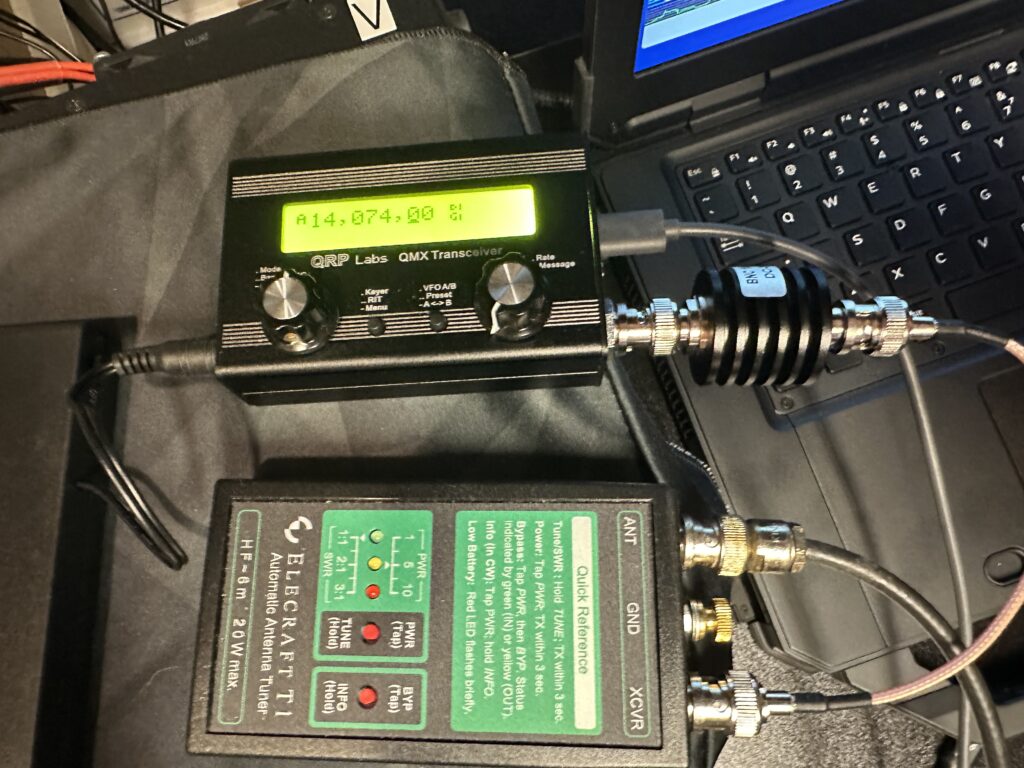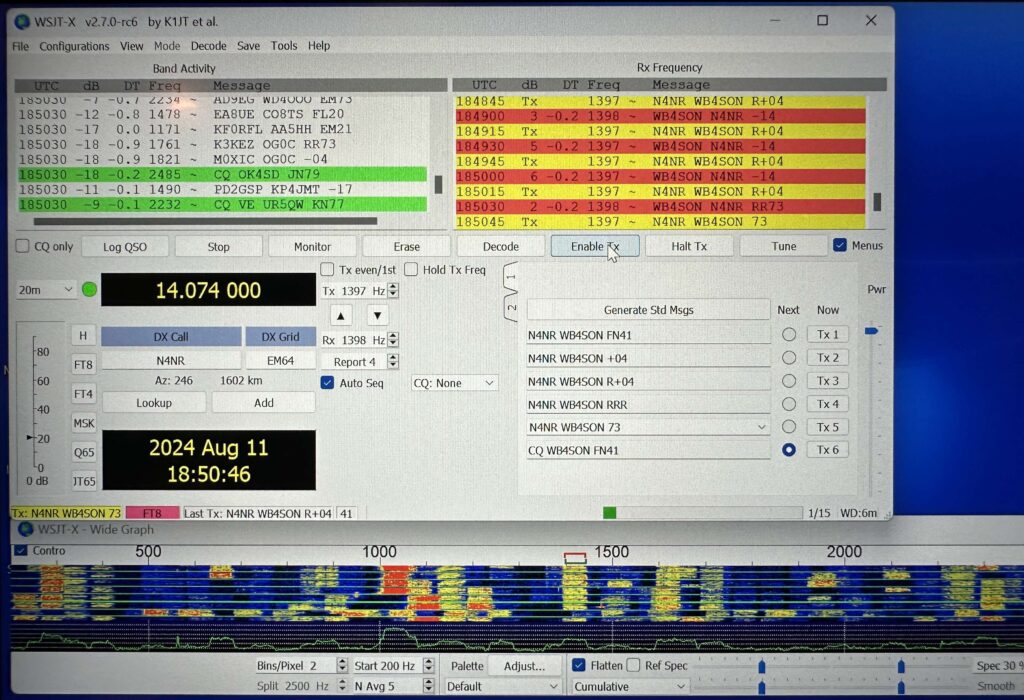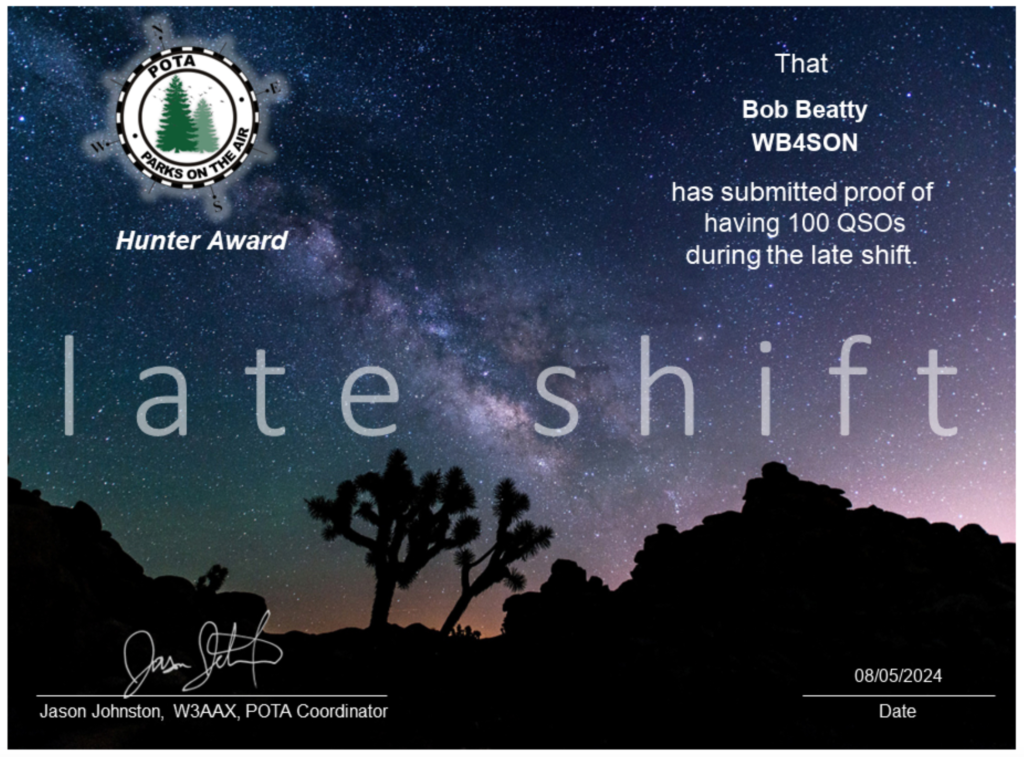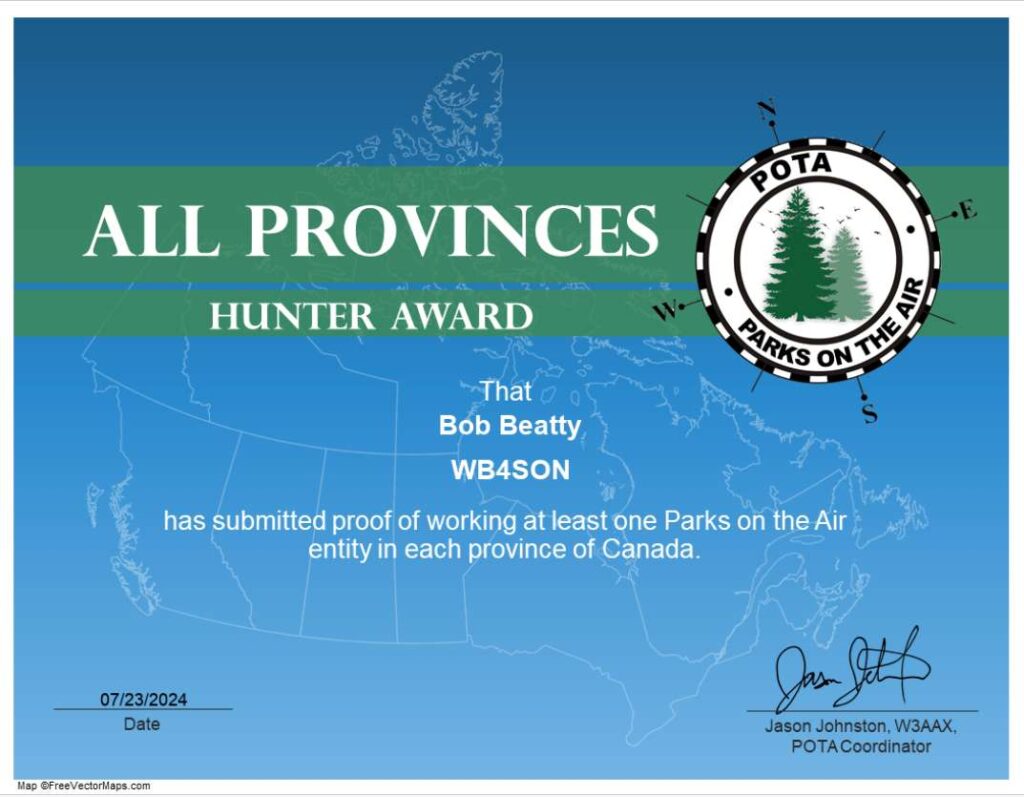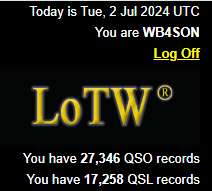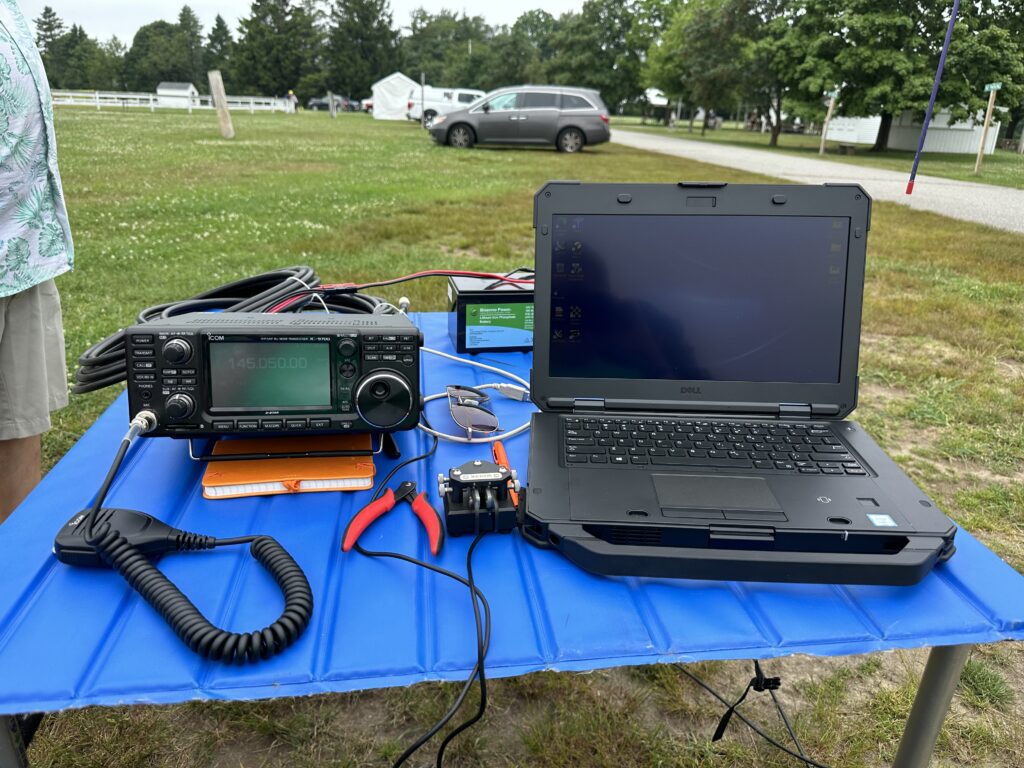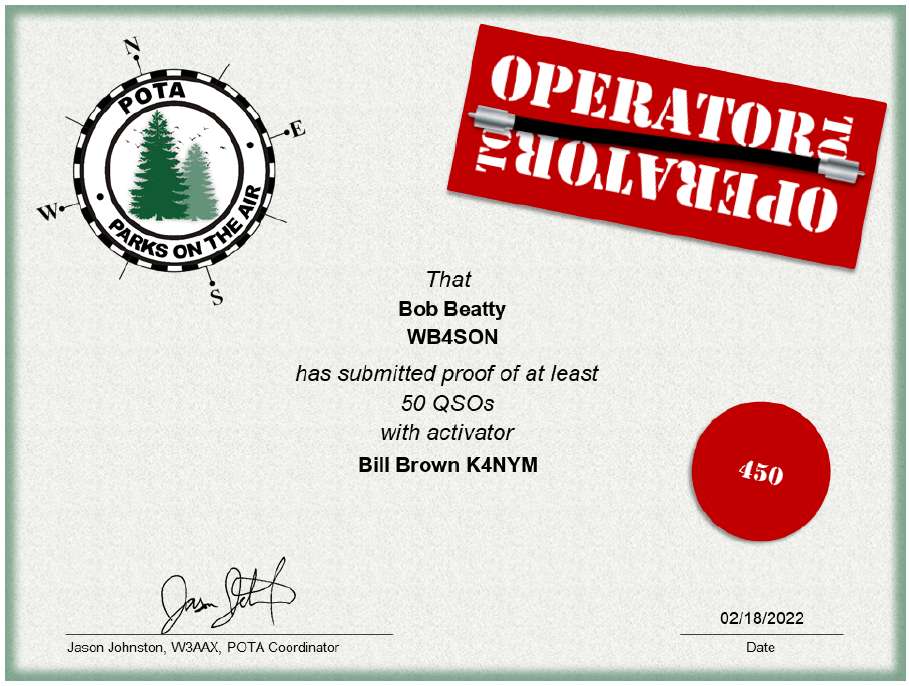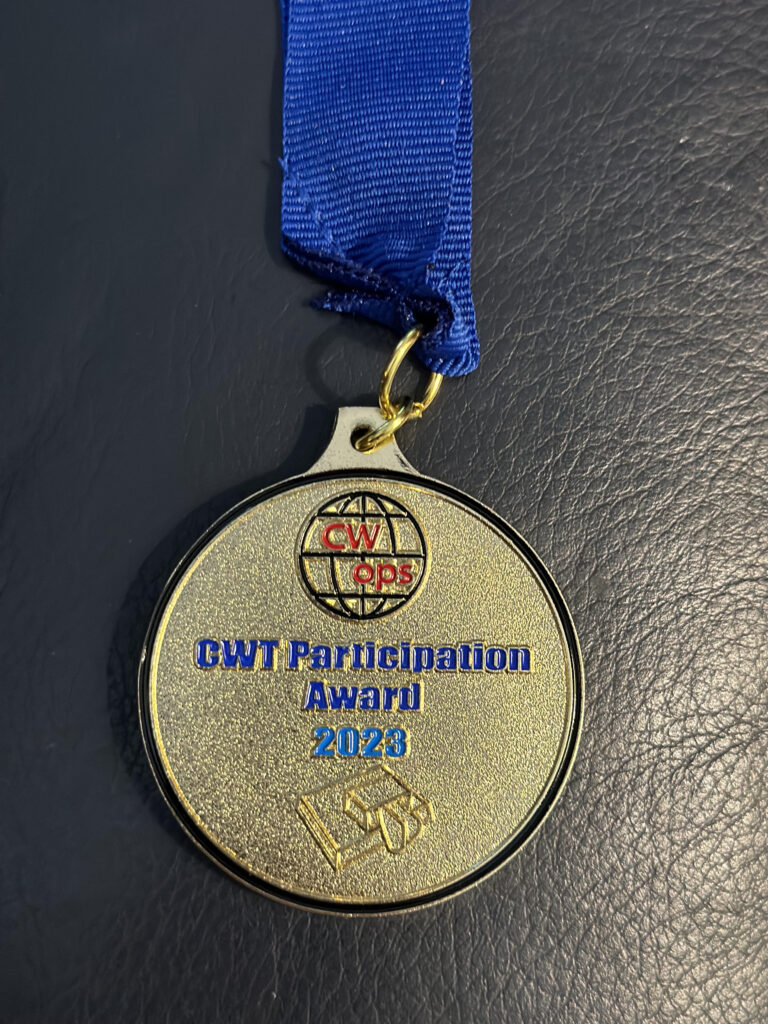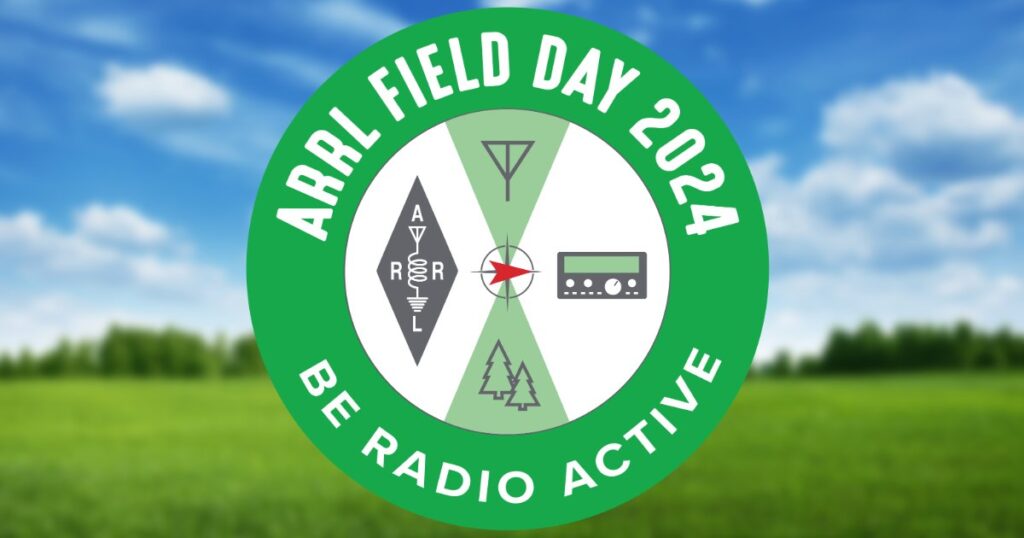Reading view
First FT8 QSOs with QRPLabs QMX Transceiver
One of my goals for 2024 was an electronics “Wildcard” where I would finish my QDX transceiver kit or some other ham related project. Today I will mark this one complete, as I finally got my QRPLabs QMX Multimode Transceiver on the air and completed a couple of FT8 contacts.
I did have a few glitches trying to get the rig on the air using WSJT-X (version 2.70 rc6). The first had to do with the short USB-C cable that came with the kit. When I tried using that, I received a pop-up message saying the USB device was unrecognized and had failed. Several folks said they had issues until they changed the USB cable, which I did, and that appeared to work just fine – COM 6 came alive.
The next issue had to do with setting the rig in WSJT-X. The manual suggested “TS-440”, which was a choice that appeared as “TS-440S”. However that did not work, and returned a pretty long failure message when I tried to the Test CAT function. The manual also suggested “TS-480”, which did appear as exactly that (no “S” at the end). That fixed the issues and WSJT-X was now in control of the QMX.
A few minutes later at 1842 UTC I responded to CQ POTA N0WHA EM91 who was -04, and received a -15 in return. At 18:48 UTC I responded to CQ POTA N4NR EM64, who was +04. I did receive a -14 report and a 73 in return. Both stations confirmed the contacts in their POTA Activator logs. So the QMX is working.
In the photo below, you can see the QMX attached to an Elecraft T1 QRP Antenna Tuner, and if you look closely you can see a 3dB attenuator installed in line with the QMX. The QMX lacks a tuner, and if it detects a high SWR, will immediately shut down the transmitter. This quick response prevents the T1 from being able to do its job. By inserting a 3dB attenuator, that guarantees no matter what the antenna load, the worst case SWR seen by the QMX is less than 3:1 – a value that no longer cuts out the transmitter. When the T1 is tuned correctly, the 3dB attenuator can be removed. If you leave it in, the 5 watt output of the QMX is reduced to 2.5 watts. 3dB of RX attenuation really doesn’t matter on the receive side.
In the photo below, you will see the exchanges with N4NR as well as the waterfall.
Late Shift Hunter Award
There is always some new award to chase in the Parks on the Air program. This morning, I finally received the Late Shift Hunter award. This took years for me as I am rarely at the radio in the evenings. But with the solar conditions causing so much difficulty during the afternoon, I have spent some time hunting after sunset. As it turns out, that often yields excellent results on 40 and 20 meters.
1500 Unique Parks for POTA
On Sunday, I finally achieved the 1,500 unique park mark for Parks on the Air. It took me 349 days to go from 1,000 to 1,500 parks. Perhaps getting to 2,000 parks might be a good goal for 2025.
This was also one of my goals for 2024. My remaining goal for 2024 is the Gold Medal for CWops CWT contests. I am currently at 95 contests, and need 120 for the gold, so 25 more to go. I usually do 3 of the 4 contest a week, so I might check that goal off by the end of September.
The XHDATA D-220 Discount Code is Here!
Visually Impaired HT Use
A good friend of mine is visually impaired. We have worked together and he has been successful using a Kenwood TS-590 on HF (it has a strange mix of voice, Morse code, and tone beeps, but you can deal with it), and a desktop VHF rig with channels programmed (he detects channel 1 by a different beep tone, then counts clicks).
I wanted him to have a HT to use. Sadly there are only a few with voice prompts. The ubiquitous BaoFeng UV-5R, is one, but it is VERY easy to accidentally stumble into a mode you can’t recover from if you can’t see. I had heard that the Wouxun KG-UV9D(Plus) was another capable HT, a bit better designed than the UV-5R, and boasting voice prompts.
Since this is a Type 90 Approved Radio, I figured it would be very simple to program some channels, and disable everything else (commercial users aren’t allowed to adjust things from a keypad). That task proved difficult as the radio has no obvious way to disable its very frustrating BAND function (half of the display is set to one band and the other half to another). One can disable the keypad, but you are still left with a VHF on one half and a UHF on the other (or dual VHF if you want), but you can only select channels on one of them (because the band button is disabled). That says anything left on the other “unused” half of the display might open the squelch.
I worked around this by programming channel 100 to be 147.985 MHz, setting the power to low, and the squelch to max 9.
The real reason this became an issue, is that the voice prompts only work for a few things, not all of them. It would be helpful to announce Band A (upper display) or Band B (lower display), or perhaps use a higher beep for A than B, but Wouxun didn’t think that through.
Please, please, please, for the love of everything sacred, radio vendors should spend more than 30 seconds thinking of how a visually impaired user would want to use your radios and realize that no amount of screen prompts will help someone get out of an unwanted situation if they can’t see. Use voice prompts for everything or at least chose your beep frequencies so someone can hear what is going on.
XHDATA D-220 – A Throwback to a Simpler Time
March to 1500 unique parks continues, along with 120 CWTs
As of today, I have 1426 unique POTA parks confirmed. Twenty days ago, the count was 1401, so I’m adding a scooch over 1 park a day. So the end of September seems like when I might get my goal of 1500 completed. And the CWT Gold Medal should wrap up by the end of October, which is when I should hit 120 (currently at 84, so 36 remain). Fingers are crossed!
Hello Old Friend!
From the ARRL: “Effective 12:00pm ET / 16:00 UTC we will be returning Logbook of The World® (LoTW®) to service.” That is fantastic news!
I uploaded the logs that I had waiting since things went down in early May. When I logged into my account today, this is what I saw:
When I synchronized DXKeeper and LotW, the most recent LotW confirmation was from May 9. So we are a couple of months behind. I was surprised there were only 47K logs in the queue (a 16 Hour delay), but I expect very few people know it is back on line. Hopefully those May and June confirmations will eventually get uploaded.
Raddy 919 Firmware Issue
So how did Field Day 2024 go for me personally?
I had a few tasks to carry out for my club, Newport County Radio Club, during Field Day 2024, which was hazy, hot, and humid (sounds familiar).
I was charged with making a satellite contact, something I had not done since 2020. I spent two weeks before ensuring that I had calibrated all the satellites that were still in the air (and bemoning all the ones that were no longer available – CAS-x, XW-x, etc.). My station is shown in the photo below (IC-9700, laptop running SATPC32, and a 3×11 Arrow antenna on a photo tripod).
The first available pass was for RS-44, and would be at the point of closest approach right at 1400 EDT. With only about 8 minutes to make a contact at that point, I was pretty confident, but imagine my disappointment when I could barely hear any singlas on the satellite and couldn’t hear my downlink at all. After that failed pass, I did some quick checking and discovered that the VHF and UHF coax cables had been attached to the wrong beam. EEK!
There was a pass of AO-73 about a half hour later, and I had no trouble making 3 SSB contacts on it (I gave up trying CW as there were no responses other than folks going up and down the band to find themselves sending endless dots and dashes). A couple of hours later there was a pass of AO-7, and I quickly made a SSB contact on that bird, just to pay homage to the little satellite that still does, 50 years later!
Another task was to pass a section manager message from our site at Glen Park (Portsmouth RI) through a VHF link to my home gateway (WB4SON-10 on 145.050 MHz). Despite the 21 mile path and some terrain between the two locations, it was an easy S9+++ connection with a full speed data link. This message was also part of the Winlink Thursday drill for the week before and after Field Day.
As I wrapped up the AO-7 contact, I felt a burst of cool air on my back, a 180 degree change of wind direction. I suspected there was a downdraft nearby, so I quickly took my equipment apart, stuffed it in my car, and headed home. A few minutes after I left, the skies opened with a deluge of rain. I felt sorry for my buddies in various tents still at the site.
When I got home, I copied the W1AW CW bulletin.
My final task was to work the CW station for the final 2.5 hours of the contest on Sunday. This year I decided to run Search/Pounce, and enjoyed contacts on 10, 15 and 20 meters.
As always, lots of fun
Still a bit under 100 new parks to go for 2024
One of my goals for 2024 is to have confirmed contacts with at least 1,500 unique POTA parks. As of Saturday June 22, I had 1,401 confirmed.
So 99 more parks to go. Things have slowed down considerably as propagation during daylight hours no longer favors fairly productive areas, as well as the need to work a unique park.
Another K4NYM Milestone: 450 O2O
Things have slowed down a bit. I suspect Bill hasn’t been out in the early morning hours as often as he has in the past due to band conditions (the past month+ has seen very weak signals on most bands up here in New England).
Nevertheless, six weeks after the last Operator-to-Operator award, I received one for 450 park contacts with K4NYM today. Thanks for always being there Bill!!!
Daylight Satellite Passes for Field Day 2024
The document attached has all the current FM and Linear Satellite passes during daylight hours for FN41 (Rhode Island)
VARA FM and SATPC32 Setting Conflict
I had been having some issues with SATPC32 and my iCOM IC-9700. Whenever I was running SATPC32 and RS-44 was active, for some reason if I used the rig’s VFO knob to tune around the passband, it would sometimes caused the Doppler adjustments to stop working. All the other satellites were just fine.
I went back to the recommended settings from the SATPC32 documentation and discovered I was twice their recommended baud rate. So I lowered things to 57600 baud. On my first test, that seemed to fix the problem with RS-44.
However, I also use that radio with WinLink and VARA FM. I knew that I was using CAT for PTT, so I needed to drop the baud rate down on that as well. Imagine my surprise at finding that 57600 baud didn’t exist as a valid value.
The fix was simple; change from PTT CAT control to COM control. I used the same COM port as I had used for CAT control (COM4 in my case), and selected the PTT pin as RTS. That worked just fine.
XHDATA Weather Radio D-608WB
Getting Ready For Field Day Satellite
I haven’t made a satellite contact in a few years as another club member was nice enough to step up. However, he had to back out this year, and I was left flat footed when everyone else took a step back; it looked like I had stepped forward to volunteer.
I spent a few hours today updating my satellite laptop with all the latest Windoze stuff, and figuring out why my IC-9700 didn’t power up (12VDC power supply had a loose AC plug). My next shock was that, for the most part, the birds I used a few years back were no longer active (bye bye CAS-x and XW-X). AO-7 is still sort of working, as was RS-44.
I was able to adjust the transmitter calibration and hear myself on RS-44, but had no responses to a CQ. That bird seemed to have very good doppler correction throughout the last half of the pass.
I also heard a few SSB calls on AO-73, so gave that a try. As usual the transmit doppler correction was about 7000 Hz off. I did make a partial SSB contact with N2FYA, but I don’t think he had the last letter of my call correct. AO-73 has always been a challenge for me due to its unpredictable frequency offsets.
I need to setup FO-118, JO-97, HO-113 and XW-4, which are all new birds for me, then get the transmit uplink calibrated for them and AO-7.
Field Day 2024 rules are clear that multiple QSOs count now, but only one FM contact may be counted per FM bird:
7.3.7. Satellite QSO: 100 bonus points for successfully completing at least one QSO via an amateur radio satellite during the Field Day period. “General Rules for All ARRL Contests” (Rule 3.7.2.), (the no-repeater QSO stipulation) is waived for satellite QSOs. Groups are allowed one dedicated satellite transmitter station without increasing their entry category. Satellite QSOs also count for regular QSO credit. Show them listed separately on the summary sheet as a separate “band.” You do not receive an additional bonus for contacting different satellites, though the additional QSOs may be counted for QSO credit unless prohibited under Rule 7.3.7.1. The QSO must be between two Earth stations through a satellite. Available to Classes A, B, and F.
7.3.7.1 Stations are limited to one (1) completed QSO on any single channel FM satellite.

